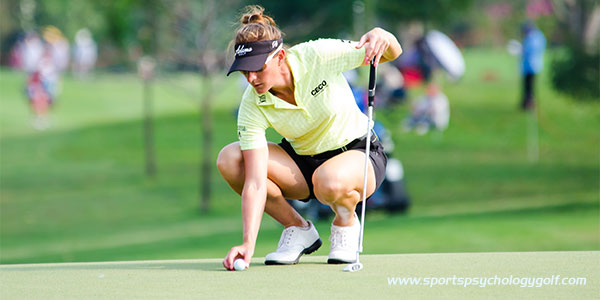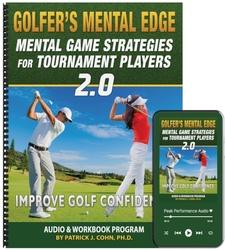
Visualization Helps Increase Confidence
Can you remember a time when you hoped to shoot your lowest score, but you were over-excited or nervous and couldn’t focus?
Have you ever stood over an important putt that you over-analyzed?
Second-guessing your decisions interferes with getting into a rhythm and freely swinging your golf club.
When you question your decisions, you are indecisive because you see or feel two options. The mental images in your mind can influence your play.
When you can’t decide on a line or a club, it’s hard to trust in your swing. In our Golf Mental Game Survey, golfers expressed a common theme of lack of trust caused by fear:
“How can I play with freedom during competition like I do during practice rounds when I have no fear?”
When you fear mishitting the ball, embarrassing yourself, missing an easy putt, scoring poorly, or being beaten by golfers with lesser ability, your trust in your game is lower.
When you are fearful, indecisive, or worried about your score, you counter this by trying to have more control over your swing, which leads to over control.
Has that strategy ever worked for you? No! You can probably recall times when a lack of trust ruined your game.
When you lack trust, you CANNOT fully immerse yourself in the moment and swing the club freely. Trust is essential for you to play at your peak.
How do you develop trust?
One strategy is to practice visualization to improve muscle memory and build confidence in your abilities. This mental skill has helped Justin Thomas improve his play after struggling with his putting over the past two years.
Thomas has worked with putting guru John Graham with visualizing, feeling comfortable before a shot, and trusting his ability to make shots during competitive rounds.
Trust helped Thomas score a 5-under 65, needing just 28 putts at the opening round of the US Open.
THOMAS: “It’s not like I’m going out and doing mechanical stuff. It’s just trying to get the muscle memory of hitting the putt as far as I want to and feeling comfortable playing different breaks and almost creating shots. That’s something that, as a feel player, as much of a feel player as I am, it’s been really helpful.”
Visualization programs the body and mind by building your muscle (motor) memory and, in essence, building trust in your ability to perform when it counts.
Using Visualization on the Golf Course:
You want to integrate visualization into your preshot routine. However, not every golfer is a visual golfer and thus you might want to use a feeling that works for you.
When I worked with Grant Waite, a few years ago at Bayhill, he said he couldn’t see the ball flight of the shot he wanted to hit. I suggested he feel the shot and not worry about seeing the ball fly to the target.
He was relieved to hear this. So don’t force yourself into a style that is not your strength.
You can visualize the ball flight, such as the shot tracer, or you can feel the flight of the ball if you are a feel player.
Related Golf Psychology Articles
- Take Control of Your Golf Confidence
- How to Dedicate Yourself to the Game of Golf
- Visualizing the Correct Golf Shot
- Subscribe to The Golf Psychology Podcast on iTunes
- Subscribe to The Golf Psychology Podcast on Spotify
Golfer’s Mental Edge 2.0

Do you suffer from fragile self-confidence after missed hitting shots or making mistakes, playing with strict or high expectations that undermine confidence, or the inability to play freely and relaxed on the course?
Successful golfers have learned how to perform with ultimate confidence in competition, so we’ve developed The Golfer’s Mental Edge 2.0 Workbook and Audio program to help you do this!
The Golfer’s Mental Edge 2.0 program includes the top 11 mental training sessions I do with my personal students to help them boost their mental game and improve consistency on the course!